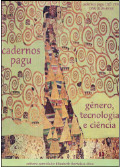Resumo
Resumo
O significado econômico e social das tecnologias do lar tem aumentado, com o reconhecimento do trabalho doméstico como trabalho e com a importância econômica crescente da força de trabalho feminina, inclusive a de mulheres casadas. Este artigo discute as especificidades das condições brasileiras em relação a esses desenvolvimentos históricos e examina como as relações de família e as inovações das tecnologias domésticas se relacionam com as maneiras de fazer o lar, no final do século vinte.
Abstract
The economic and social significance of household technologies has increased with both the recognition of domestic labour as work and the growing economic importance of the female labour force, including that of married women. This article discusses the particularities of Brazilian conditions regarding these historical developments and examines how family relations and innovations in household technologies relate to home life at the end of the twentieth century.
Referências
(O Estado de S.Paulo, Folha de S.Paulo), Campinas. O levantamento sobre o qual me baseio cobriu um período de 5 meses: fevereiro a junho de 1997.
ALVES, Maria Inez Masaro. A construção do conceito de família através das imagens da televisão. IFCH-UNICAMP, 1997.
BESSE, Susan K. Restructuring Patriarchy: The Mobilization of Gender Inequality in Brazil, 1914-1940. Chapel Hill and London: University of North Carolina Press, 1996.
BIJKER, Wiebe E. and LAW, John. (eds.) Shaping Technology/Building Society. Cambridge, Mass, MIT Press, 1992. BIJKER, Wiebe
COCKBURN, Cynthia and FURST-DILIC, Ruza. (eds.) Bringing Technology Back Home. Gender and technology in a changing Europe. Buckingham, Open University Press, 1994
COCKBURN, Cynthia and ORMROD, Susan. Gender and Technology in the Making. London, Sage, 1993.
COWAN, Ruth Schwartz. More Work for Mother: the ironies of household technology from the open hearth to the microwave. New York, Basic Books, 1983. (Cap. 5 examina as alternativas históricas que não prevaleceram.)
Depoimento de Steven Riedel, vice-presidente da GE Appliances. Exame, 23 de abril de 1997, p.64.
D'INCAO, Maria Angela. Mulher e família burguesa. In: PRIORE, Mary Del. Op.cit., pp.223-240.
DIAS, Maria Odila Silva. Power and Everyday Life. The Lives of Working Women in Nineteeenth-Century Brazil. Cambridge, Polity Press, 1995. Publicado no Brasil como: Quotidiano e poder em São Paulo no século XIX – Ana Gertrudes de Jesus. São Paulo, Brasiliense, 1984.
DIEESE. Brastemp: Produtos modernos, arcaicas relações de trabalho. Trocando em Miúdos, Subseção DIEESE, Sindicato dos Metalúrgicos de SBC e D., Informativo Sócio-Econômico nº 7, 1988
FALCI, Miridan Knox. Mulheres do Sertão Nordestino, pp.241-277
Folha de S. Paulo, 4 Abril de 1997, caderno 2, p.12.
Folha de S.Paulo, 5 de maio de 1997.
Folha de S.Paulo, 29 de abril de 1997
FONSECA, Cláudia. Ser Mulher, mãe e pobre, pp.510-553
GENDRIN, V. A. 1817:64. In: MOREIRA LEITE, Miriam. (org.) Op.cit., p.43.
GITAHY, Leda et alii. Relações Interfirmas e gestão de recursos humanos na cadeia produtiva de linha branca. FINEP/CEDES/CNPq, UNICAMP, 1997
HUGHES, Thomas and PINCH, Trevor. (eds.) The Social Construction of Technological Systems. Cambridge, Mass., MIT Press, 1989
LAUDERDALE GRAHAM, Sandra. House and Street. The Domestic World of Servants and Masters in Nineteenth-Century Rio de Janeiro. Austin, University of Texas Press, 1992 (First Edition Cambridge University Press, 1988).
LOVEL, P. Race, Gender and Development in Brazil. Latin American Research Review, 29 (3), 1994, pp.7-35.
MACKENZIE, Donald and WAJCMAN, Judy. (eds.) The Social Shaping of Technology. Milton Keynes, Open University Press, 1985.
NETO, B. R. de M. A indústria de eletrodomésticos de linha branca: tendências internacionais e situação no Brasil. Relatório de Pesquisa, Instituto de Economia, UNICAMP, Campinas, 1992.
NICHOLSON, Linda and SEIDMAN, Steven. (eds.) Social Postmodernism. Beyond identity politics. Cambridge, Cambridge University Press, 1995.
O Estado de S.Paulo, 25 de maio de 1997, Caderno de Imóveis, p.1.
PEDRO, Joana Maria. Mulheres do Sul, pp.278-321. In: PRIORE, Mary Del. História das Mulheres no Brasil. São Paulo, Editora Contexto e Unesp, 1997.
PEGLER, Lee. Workers, Unions and the Labour Process: The case of the Brazilian White Goods Industry, 1985-93. Outline of a PhD Theses, LSE, 1995.
RAGO, Margareth. Trabalho Feminino e Sexualidade. In: PRIORE, Mary Del. Op.cit., pp.578-606.
SCHOR, Juliet B. The Overworked American. The Unexpected Decline of Leisure. New York, Basic Books, 1993.
SCOTT, Joan W. Gender and the Politics of History. New York, Columbia University Press, 1988.
SILVA, E. Fazendo Gênero na Cozinha. Revista Latinoamericana de Estudios del Trabajo nº 7, Abril de 1998.
SILVA, Elizabeth B. RESEARCH REPORT Household Technologies: Patterns of innovation and gender relations. Submitted to the Economic and Social Research Council, London, 1997.
SILVA, Elizabeth B. Teorias sobre Trabalho e Tecnologia Doméstica. Textos para Discussão nº 19, DPCT/IG/UNICAMP, 1997.
SILVER, Hillary. Only so many hours in a day: time constraints, labour pool and demand for consumer services. Service Industries Journal 7, 1987, pp.26-45
SIQUEIRA, Flailda B.G. A mulher margarina. Uma representação dominante em comerciais de TV nos anos 70 e 80. Dissertação de mestrado, Instituto de Artes, UNICAMP, 1995.
TOLEDO, J. C. Indústrias de Formas – “Linha Branca”. São Paulo, DIEESE/FINEP, 1989
TOUSSAINT-SAMSON, Adèle. 1815:166. In: MOREIRA LEITE, Miriam. (org.) A condição feminina no Rio de Janeiro. Século XIX. São Paulo, Hucitec/Edusp, 1981, p.44.
Viver Bem, ano 7, ed. 41, 1997, p.56.
Whirlpool Foundation Study. Part One: Women the New Providers, May 1995. (Families and Work Institute, USA). Part Two: Women: Setting New Priorities, January 1996 (MORI, London).

